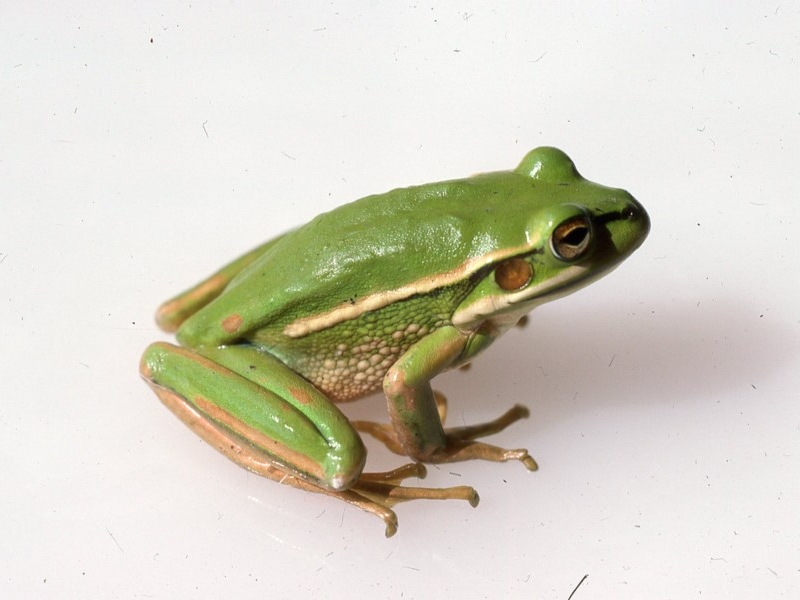Elected representatives in government are in charge of the policy and funding that can make or break saving threatened species. Their decisions and actions matter.
Cowper has or used to have 27 threatened animals within its boundaries. One of them is me, the Green and Golden Bell Frog.
We took care to attach appropriate images that are as close to representative of each species as our resources and the availability of images allowed. However, we could not ensure perfect accuracy in every case. Some images show species that share the same genus but not at the species or subspecies level.
Green and Golden Bell Frog
Litoria aurea
Status: Vulnerable
The Environment Protection and Biodiversity Conservation Act 1999 (EPBC Act) lists threatened species under six categories:
Extinct, Extinct in the wild, Critically Endangered, Endangered, Vulnerable, Conservation dependent. Read more about these categories
Litoria aurea is found across 44 electorates.
The Green and Golden Bell Frog is a large dull olive to bright emerald-green frog reaching 85 mm in length. The frog has a number of distinguishable features which aid its identification; the dorsum of the frog has large irregular blotches ranging from brown to rich golden-bronze and has a yellowish stripe running from behind the eye to the lower back which is bordered by a black stripe that can extend through the eye to the nostrils. The hind toes of the frog are almost fully webbed but the fingers of the front feet lack webbing. The frog also has a distinct tympanum.¹
Explore more about this species on the Atlas of Living Australia




Explore more about the threats facing species on our Resources page.
- Scented Acronychia (Acronychia littoralis)
- Dwarf Heath Casuarina (Allocasuarina defungens)
- Allocasuarina thalassoscopica (Allocasuarina thalassoscopica)
- Hairy-joint Grass (Arthraxon hispidus)
- Trailing Woodruff (Asperula asthenes)
- Orara Boronia (Boronia umbellata)
- Callistemon pungens (Callistemon pungens)
- Glenugie Karaka (Corynocarpus rupestris subsp. rupestris)
- Leafless Tongue-orchid (Cryptostylis hunteriana)
- White-flowered Wax Plant (Cynanchum elegans)
- Bluegrass (Dichanthium setosum)
- Diuris eborensis (Diuris eborensis)
- Small Snake Orchid (Diuris pedunculata)
- Craven Grey Box (Eucalyptus largeana)
- Narrow-leaved Peppermint (Eucalyptus nicholii)
- Euphrasia arguta (Euphrasia arguta)
- Green Waxberry (Gaultheria viridicarpa)
- Mountain Angelica (Gingidia rupicola)
- Grevillea guthrieana (Grevillea guthrieana)
- Tall Velvet Sea-berry (Haloragis exalata subsp. velutina)
- Monkey Nut (Hicksbeachia pinnatifolia)
- Kardomia prominens (Kardomia prominens)
- Macadamia Nut (Macadamia integrifolia)
- Rough-shelled Bush Nut (Macadamia tetraphylla)
- Clear Milkvine (Marsdenia longiloba)
- Biconvex Paperbark (Melaleuca biconvexa)
- Neoastelia spectabilis (Neoastelia spectabilis)
- Dorrigo Daisy-bush (Olearia flocktoniae)
- Milky Silkpod (Parsonsia dorrigoensis)
- Knotweed (Persicaria elatior)
- Lesser Swamp-orchid (Phaius australis)
- Nightcap Plectranthus (Plectranthus nitidus)
- Scrub Turpentine (Rhodamnia rubescens)
- Native Guava (Rhodomyrtus psidioides)
- Samadera sp. Moonee Creek (Samadera sp. Moonee Creek )
- Ravine Orchid (Sarcochilus fitzgeraldii)
- Fragrant Pepperbush (Tasmannia glaucifolia)
- Austral Toadflax (Thesium australe)
- Triplarina imbricata (Triplarina imbricata)
- Tylophora woollsii (Tylophora woollsii)
- Willi Willi Zieria (Zieria lasiocaulis)
- Headland Zieria (Zieria prostrata)
You are in federal electorate Cowper.
